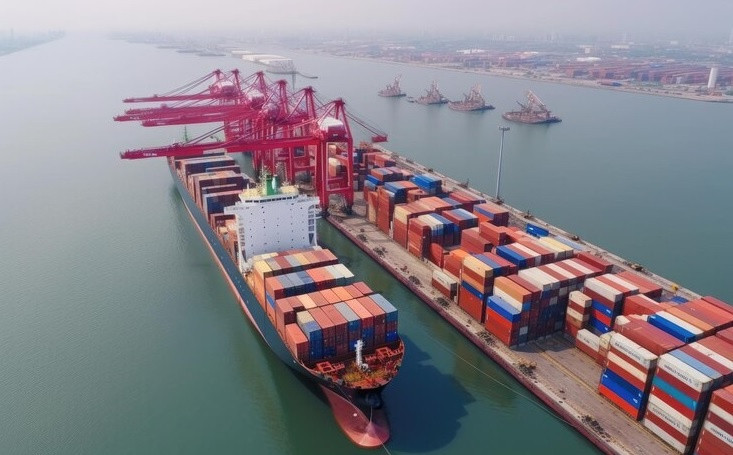 |
Last month, three business associations in the logistics sector highlighted rising and unannounced fees charged by foreign shipping lines, which they say are making conditions tough for exporters.
After the Lunar New Year holiday, the Vietnam Shippers’ Council sent a letter to the government, relevant ministries, and agencies on strengthening surcharge management of foreign shipping lines. Accordingly, the council proposed adjusting terminal handling charges and surcharges of foreign shipping lines.
The Vietnam Logistics Business Association (VLA) claimed that foreign shipping lines only announced the adjusted prices 15 days before the application time without any inspection or explanation on fees, surcharges, or any reports or constraints from any regulations of the authorities. Then they increased surcharges sharply, causing frustration for exporters.
In early February, the Vietnam Ship Agents, Brokers, and Maritime Services Providers Association sent a document to ministries and agencies to claim that foreign shipping lines were collecting about 10 types of surcharges for goods at very high rates, such as terminal handling charges ($140-265), document surcharges ($25), fuel surcharges ($15), e-delivery ($25), container balancing fees ($28), equipment balancing fees ($95), and sulphur emission reduction surcharges ($20-100).
Some shipping companies list the freight rate from Vietnam to West US ports as $2,650, to East US ports as $3,900, and to Europe as $4,900 per 40-foot container.
Associations said that it is necessary to research Vietnamese law in combination with international practices to manage surcharge collection of foreign shipping lines.
Nguyen Thanh Hoa, a representative of an exporter to the United States, said that recent tensions in the Red Sea are negatively impacting production and business.
“Orders have been gradually recovering, but such tensions have changed shipping lines’ routes to go around the Cape of Good Hope, and extend shipping journeys by 10-15 days more than usual, significantly increasing costs. This is causing many difficulties for businesses exporting goods to the US and EU,” Hoa said.
Hoang Thi Lien, chairwoman of the Vietnam Pepper Association, said that the EU market accounted for around one-fifth of the total export value of the entire industry. Pepper exporters are greatly affected by the sharp surge of the shipping cost to the EU market by up to six-fold compared to December.
“One business loaded goods onto ships on December 20, but 15 days later a surcharge of $2,000 was applied on a 40-foot container. The arbitrary application of fees, without prior notice or agreement, enables exporters to fall into a passive situation that they have no way of working around,” Lien said. “If exporters do not pay this additional surcharge, they will send an additional late payment surcharge, which makes them frustrated.”
The US and EU are Vietnam’s two main export markets. Last year, Vietnam’s import-export turnover of goods with the European region was $71.14 billion and with the North America was $122.3 billion.
The total import-export turnover of these two areas accounts for 28.4 per cent of the total import-export turnover value of the country in 2023. With such a large amount of traded goods, even a small fluctuation in freight prices can have a severe effect on exporters.
Le Quang Trung, vice chairman of the VLA and deputy general director of Vietnam Maritime Corporation, said businesses should diversify transportation methods.
“For example, high-value goods can move by air instead of sea. In addition, we should further exploit Asian markets because shipping rates in this region have only increased slightly, by 10-15 per cent,” he said.
With freight prices trending up, the Vietnam Maritime Administration (VMA) assigned port authorities of Haiphong, Ho Chi Minh City, and Vung Tau to coordinate with shipping lines to evaluate fluctuations in shipping prices, the transport situation, and the ability to provide ship supply to the market.
A representative of the VMA said that shipping lines must publicly post freight rates and surcharge issues on their website and inform customers.
“If there is a change or increase in surcharges, shipping companies must provide notification at least 15 days in advance. If shipping lines immediately increase surcharge prices without notice or apply them incorrectly, we will handle violations when receiving feedback from exporters,” the representative said.
Tran Thanh Hai, deputy director of the Ministry of Industry and Trade’s Foreign Trade Agency, emphasised the updated information and predicted a positive response, along with appropriate response measures, aiming to minimise the negative impacts of the Red Sea issue. “Shipping lines should maintain routes and bring back empty containers to ensure import and export activities. They should strictly comply with regulations on listing, fares, and surcharges,” Hai said.
Irfan Ulhaq, a lecturer from RMIT, observed that firms are looking at stockpiling key components or finished goods to buffer against disruptions, although this requires careful inventory management. “Adopting flexible operations, including adjusting production schedules, product lines, and delivery methods, is crucial for responding to supply chain disruptions. Embracing AI and blockchain can also enhance supply chain management,” said Ulhaq.
Source: VIR